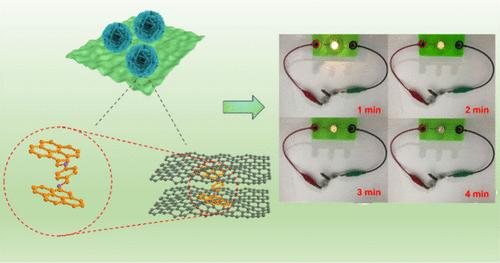用于超级电容器的导电分子修饰还原石墨烯氧化物上的 Cu2S/MoS2 纳米球
IF 5.5
2区 材料科学
Q2 MATERIALS SCIENCE, MULTIDISCIPLINARY
引用次数: 0
摘要
MoS2 具有极具吸引力的二维(2D)薄片结构,可为双层电荷存储提供较大的表面积和较高的固有快速离子电导率,因此是一种前景广阔的电极材料。然而,二维材料往往存在易堆叠的问题,这大大削弱了材料的固有优势。将 MoS2 设计成具有大比表面积的花朵形态,并与石墨烯相结合,是解决 MoS2 纳米片堆叠缺陷以实现实际应用的可行方法。导电分子(CM)的苯基与芘基形成 33.2° 的夹角,用来斜向支撑石墨烯层,从而获得比表面积更大的石墨烯化合物。然后在改性材料表面生成 Cu2S/MoS2 纳米球,得到 Cu2S/MoS2@CM@rGO。在此,我们设计并构建了 Cu2S/MoS2@CM@rGO 复合材料,作为电池型超级电容器的电极材料。用 Cu2S/MoS2@CM@rGO 与 AC(活性碳)组装的 ASC 器件显示出 981.8 W kg-1 的功率密度和 36.9 Wh kg-1 的能量密度。值得注意的是,当两个固态 ASC 串联在一起时,一个小灯泡可以持续点亮 3 分钟,这证明了 Cu2S/MoS2@CM@rGO 在能量存储方面的巨大潜力。本文章由计算机程序翻译,如有差异,请以英文原文为准。

Cu2S/MoS2 Nanospheres on Conductive Molecule Modified Reduced Graphene Oxide for Supercapacitors
MoS2 has an attractive two-dimensional (2D) flake structure, which provides a large surface area and high inherent fast ionic conductivity for double-layer charge storage; thus, it is a promising electrode material. However, 2D materials often suffer from the problem of easy stacking, which greatly weakens the inherent advantages of materials. Designing MoS2 into flower morphology with a large specific surface area and combining it with graphene are feasible methods to solve the stacking drawback of MoS2 nanosheets for practical applications. The conductive molecule’s (CM) phenyl group and pyrene group form an angle of 33.2°, which is used to obliquely support the graphene layer to obtain graphene compounds with a larger specific surface area. Then Cu2S/MoS2 nanospheres are generated on the surface of the modified material to afford Cu2S/MoS2@CM@rGO. Here, we designed and constructed Cu2S/MoS2@CM@rGO composite as electrode materials for a battery-type supercapacitor. An ASC device assembled with Cu2S/MoS2@CM@rGO with AC (active carbon) shows a power density of 981.8 W kg–1 under 36.9 Wh kg–1 energy density. Significantly, a tiny light bulb can be kept lit for 3 min when two solid-state ASCs are coupled in series, which demonstrates the high potential of Cu2S/MoS2@CM@rGO for use in energy storage.
求助全文
通过发布文献求助,成功后即可免费获取论文全文。
去求助
来源期刊

ACS Applied Nano Materials
Multiple-
CiteScore
8.30
自引率
3.40%
发文量
1601
期刊介绍:
ACS Applied Nano Materials is an interdisciplinary journal publishing original research covering all aspects of engineering, chemistry, physics and biology relevant to applications of nanomaterials. The journal is devoted to reports of new and original experimental and theoretical research of an applied nature that integrate knowledge in the areas of materials, engineering, physics, bioscience, and chemistry into important applications of nanomaterials.
 求助内容:
求助内容: 应助结果提醒方式:
应助结果提醒方式:


